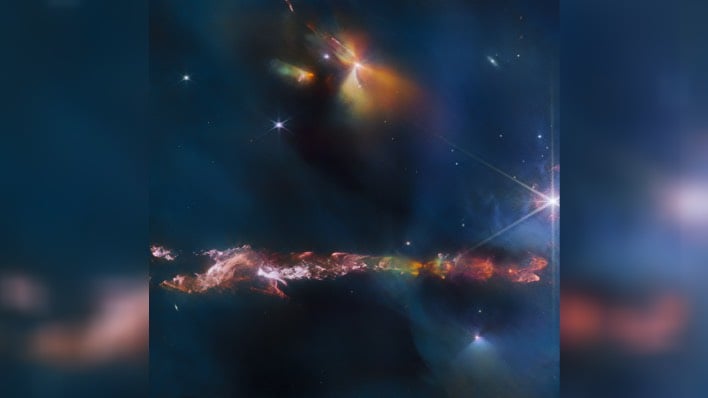JWST Spots A Starry Space Object In Amazing Detail And It’s Jaw-Dropping

Herbig-Haro objects were named after the first astronomers to discover them, George Herbig and Guillermo Haro. The deep space objects come in a wide variety of shapes, with the basic configuration usually being when two jets of heated gas, ejected in opposite directions from the protostar, stream through space. The latest image of Herbig-Haro 797 was captured by Webb’s Near-Infrared Camera (NIRCam) instrument.
In the image above, HH 797 can be seen in the lower portion of the image. It is near the young open star cluster IC 348, which NASA says is near the eastern edge of the Perseus dark cloud complex. The objects in the top portion of the image are thought to be two more protostars.
“Infrared imaging is powerful in studying newborn stars and their outflows, because the youngest stars are invariably still embedded within the gas and dust from which they are formed,” explained Webb astronomers. “The infrared of the star’s outflows penetrates the obscuring gas and dust, making Herbig-Haro objects ideal for observation with Webb’s sensitive infrared instruments.”
Earlier studies found that for cold molecular gas associated with HH 797, most of the red-shifted gas is found to the south, while the blue-shifted gas is to the north. Those earlier studies also found a gradient gas across the outflow. This led to the conclusion that this was due to the outflow’s rotation.
However, Webb’s intricate high-resolution image of HH 797, astronomers and researchers can see that what was once thought to be one outflow is instead two nearly parallel outflows with their own separate series of shocks. The researchers pointed out that this would also explain the velocity asymmetries.
Researchers remarked, “The source, located in the small dark region (bottom right of center in the image), and already known from previous observations, is therefore not a single but a double star. Each star is producing its own dramatic outflow.”
The new image captured by Webb of Herbig-Haro 797 is just one example of the power the telescope possesses. As Webb continues to amaze, astronomers, scientists, and researchers will surely continue to rewrite what was once believed to be true.


